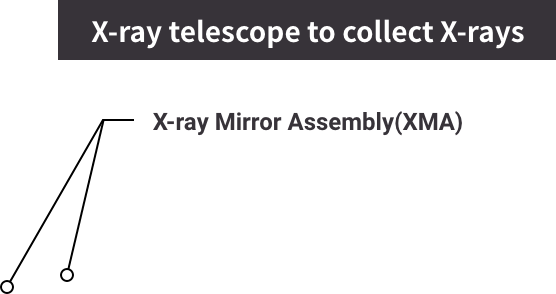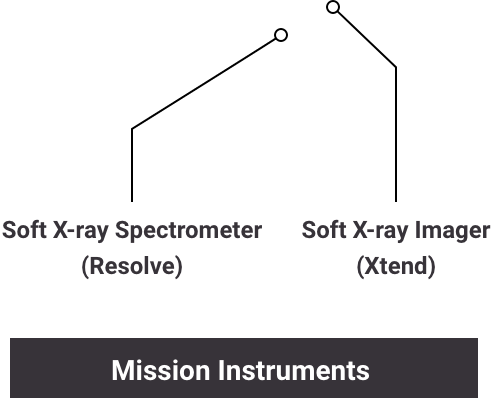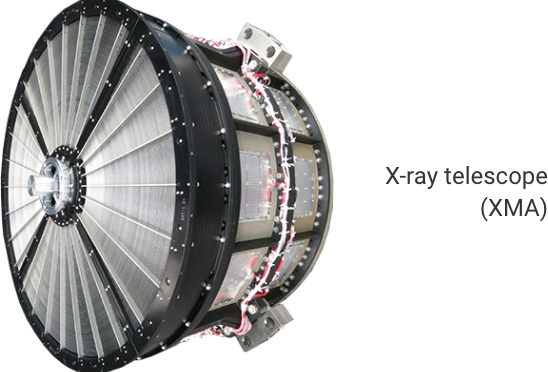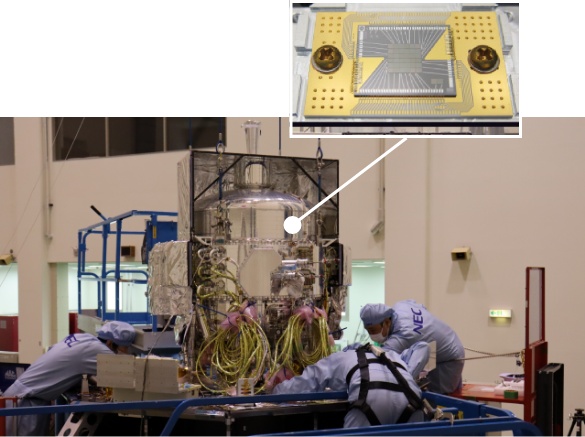Technology

Spectroscopy and
Imaging of XRISM
Spectroscopy is the measuring of the strength of light at different wavelengths, in the same way our eyes can see different shades of colors. In X-ray astronomy, by making a precise measurement of wavelength (energy) of X-ray photons in the universe, we can measure the temperature of celestial objects, the type of matter they contain, and their speed. The micro-calorimeter, Resolve, has excellent spectroscopic capabilities. On the other hand, imaging takes a picture of an object. By examining the shape and brightness distribution, we can learn about the spatial extent of celestial objects. XRISM has an X-ray CCD camera, Xtend, which can image objects over a wide field of view.




XMAX-ray Mirror Assembly
X-ray telescope to collect X-rays
with high penetrating power
To observe in X-rays, it is necessary to focus the incoming photons down to a focal point, just as with an optical telescope. However, it is impossible to focus X-rays with a regular glass convex mirror because of their short wavelength and high penetrating power. So how can they be collected?
X-ray telescopes can collect X-rays down to a focal point using a phenomenon called total internal reflection. This phenomenon happens when an X-ray photon strikes the mirror, made of material with a high reflective index, at a shallow angle. For example, if one is underwater and looks up at the surface, not only is the sky is visible overhead, but the water surface apart from us reflects inside the water like a mirror. This is because the light could not go through the water's surface, and returned back inside the water because the atmosphere has a lower reflective index.
As we see with the boundary surface between water and air, X-rays can be totally internally reflected when they are incident on a very smooth surface at a shallow grazing incidence angle. Utilizing this property, an X-ray telescope can focus X-rays. In fact, the X-ray mirror is made of thin conical shells concentrically aligned, like a "Baumkuchen", with a gold coating on the inner surface. The surface is polished, and is so flat that any roughness is less than one millionth of a millimeter.







ResolveSoft X-ray Spectrometer
Measuring ultra-precise energies using the micro-calorimeter
A micro-calorimeter is an instrument to measure the energies of X-ray photons by using the fact that the temperature slightly rises when an X-Ray hits its elements. It was developed by a Japan and USA collaborative team, and is expected to be a new observing instrument to lead the next generation of X-Ray astronomy. It is possible to measure the incoming energy of an X-ray photon; in other words, one can measure the wavelength very precisely by using the micro-calorimeter. This instrument makes it possible to accurately measure the temperature or the composition of an observed X-ray object. And by using the "Doppler effect", we can detect the motion of the target source. Measurements that had never been possible to have at X-ray wavelengths are now available. The principle of a micro-calorimeter is very simple. When the instrument observes X-rays, the energy of the X-ray photon changes to heat. This is the same phenomenon by which matter becomes hot when exposed to light. The amount of energy of the X-ray photon can be measured by measuring the change of temperature in the detector. However, X-rays from celestial sources are very faint and the temperature raises in the instrument are so small that the instrument needs to cool its temperature close to absolute zero. Thermometers with extremely high sensitivity are needed.




XtendSoft X-ray Imager
X-ray imaging with a CCD camera
Similar to optical imagers, an X-ray CCD camera gathers X-rays from sources and produces a corresponding image. The principle theory is not very different from a common digital camera. Multiple small semiconductors are arranged in series, converting X-rays to electrons and then to electrical signals that produce a final image. For optical light, one electron is emitted per photon. However, in the case of X-rays and due to the nature of high energy X-ray photons, multiple electrons are emitted for each X-ray photon. As a result, it is possible to measure the energies of individual X-ray photons by measuring the number of emitted electrons, which is proportional to the photon's energy. Using this property, we are able to measure the "color" of each X-ray photon without using color filters commonly used in optical imaging.

Mission Specification
The XRISM spacecraft will be launched on an H-IIA rocket to low-Earth orbit (an altitude of 550 km). Resolve uses liquid helium to cool down the X-ray spectrometer. The liquid helium will evaporate in 3 years. Therefore, the design life of the instrument is 3 years, though it is possible to continue to observe afterwards using mechanical coolers.
- Mission instruments
- Resolve (Soft X-ray Spectrometer)
Xtend (Soft X-ray Imager) - Mass
- 2.3 t
- Design life
- 3 years
- Orbit Altitude
- 550 +/- 50 km
- Orbit Inclination
- 31 degree
- Home
- Technology

